Your feedback is important to us
Please provide any feedback you have. Thank you!
Thank you!
Your feedback has been submitted.
- Partnership for Assessment of Readiness for College and Careers
Please provide any feedback you have. Thank you!
Your feedback has been submitted.

See what skills are tested, understand your child's scores, and get ideas for how you can help at home.
When reading literature, sixth graders should explain how an author develops the narrator’s point of view. For example, they should be able to explain how the events in the beginning of a story or narrative poem lead naturally to those in the end of the story and how details help readers see these connections. To back up these conclusions, students should be able to point to words or passages from the poem, play, or story and explain how they help a reader to understand the narrator’s point of view.
Watch how a teacher gets middle schoolers to talk about what they’re reading.

Students also need to compare how two different types of literature, or genres, approach a similar theme. For example, how do Island of the Blue Dolphins (historical fiction) and Ella Enchanted (fantasy) address the theme of girls surviving in their environments in different ways?
Sixth graders should be able to recognize how a text’s structure influences the story. For instance, they should see how very short chapters contribute to the suspense in a mystery story.
Offer your child opportunities to practice reading challenging texts, such as Madeleine L’Engle’s A Wrinkle in Time or Mark Twain’s The Adventures of Tom Sawyer.
Make reading fun by catering to your child’s diverse interests. Explore mystery, science fiction, poetry, and plays. Your sixth grader should be reading for at least 30 minutes a day. Here are some challenging books that also play to sixth graders’ interests.
Want to know one of the most powerful ways to inspire your child to read? Read for your own pleasure! Seeing you read a book or magazine goes a long way toward showing how reading enriches a person’s life. Establish a regular 30-minute (or more) family reading time (daily is best, but weekly sends the right message). Everyone in the family has a book, magazine, or tablet to read. When the time ends, ask everyone to share what they found interesting or confusing about their reading.
Find out what your child enjoys reading and look for audiobooks that can jumpstart the process. (The public library has a large collection of audiobooks that you can borrow for free.) Have her listen to the first few chapters, maybe on a car ride. Then, once she’s hooked, give her the book so she can finish the story. Children can often understand texts above their level if they’re highly interested. Audiobooks can be a wonderful way to add some reading firepower to long school commutes!
Sixth graders need to be good at comparing versions of stories, describing plots, and using details from a story when summarizing. Ask your child’s teacher if your child has these skills. Is your child quick to identify the theme? Does he tend to draw the right conclusions? When your child points to details, are they integral to the story or extraneous? Knowing your child’s strengths and weaknesses will help you figure out the best ways to help.
Sixth graders are learning how to read science and social studies texts. They need to know how to analyze what these texts say, whether they’re about scientific concepts (the Earth’s orbit, say) or they are historical documents (like the First Amendment to the Constitution).
Sixth graders are expected to read science and social studies articles and books with a critical eye. This means asking questions that get at the author’s intention: What is the author’s background? Who is the author writing for? Why might the author write this piece at this moment in history?
Sixth graders also need to learn to recognize which statements are backed by evidence and which are not. What proof does the writer give for her ideas? Does the evidence make sense? As they read science and social studies texts they should be able to explain if information is a fact, a judgement based on research, or an opinion.
At this stage, your child should recognize which details are related to the central idea and which are slightly off topic. Take an article about how great white sharks use the element of surprise to hunt their prey. It might be interesting to know that they can go one or two months without another big meal, but that information is not directly related to their use of surprise in hunting.
Sixth graders should be able to explain how graphic aids, like a photograph or chart, contribute to the information in the text.
Watch how middle schoolers do research on a topic.

Sixth graders should be able to precisely follow a procedure to carry out a science experiment. In social studies, they should be able to identify important steps in a process, for example describing how a bill becomes a law.
Offer your child opportunities to practice reading texts that are considered challenging for sixth graders and are related to science and social studies concepts she’s studying, such as Vincent Van Gogh: Portrait of an Artist by Jan Greenberg and Sandra Jordan.
Make reading fun by catering to your child’s interests. This means not just reading books but magazines, online articles, and blogs. Your sixth grader should be reading for at least 30 minutes a day. Here are some challenging books for your sixth grader.
Want to know one of the most powerful ways to inspire your child to read? Read for your own pleasure! Seeing you read the morning newspaper goes a long way toward showing how reading can enrich a person’s life. One night a week, have everyone read one nonfiction article and discuss it over dinner.
Children learn through doing. Explore a museum or park and let your child’s questions about what he sees guide your conversation. By talking about that jellyfish at the aquarium, for example, you will build vocabulary and stimulate curiosity. Then look for a book that builds on something that caught your child’s interest. (Museums can be pricey, but most have at least one free day per month.)
Sixth graders need to be good at identifying the central idea, drawing conclusions, and finding evidence in what they read. When you talk to your child’s teacher, ask: Is my child able to identify the central idea? Does he tend to draw the right conclusions? Does my child typically use strong evidence to back up her thinking or is she sidetracked by unrelated details? Knowing your child’s strengths and weaknesses will let you help your child build these skills. Ask the teacher for suggestions on what kinds of questions to ask your child at home to help him focus on important details in what he reads.
As a sixth grader’s vocabulary grows, so should his ability to understand the subtle differences in meaning between similar words. Sixth graders learn to compare the emotions associated with words that have similar meanings. For example, the words stingy and thrifty both have to do with spending little money. However, stingy describes someone who doesn’t want to give or spend, while thrifty describes someone who uses money carefully and is not wasteful. Stingy has a negative connotation.
To make sense of unknown words, sixth graders should be able to use several strategies, including figuring out a word’s meaning from context, looking up a word in the dictionary, and getting the idea of a word from its root word, prefix, or suffix. For example, if they know micro means small, they can figure out that microprocessor might mean a really small processor.
Sixth graders should also be able to think symbolically when reading figurative language. When faced with an idiom such as stuck between a rock and a hard place, they should know this isn’t about being wedged underneath a literal boulder. Figurative language can be especially challenging for kids who are learning English. Imagine trying to understand Let sleeping dogs lie by translating it word for word.
Sixth graders continue to learn academic vocabulary, words used broadly in many subjects, like encourage or infer. But they should also be learning words used in social studies and science, such as amendment in history class and solstice in science.
It’s important for sixth graders to build their academic vocabulary. These words are broadly used, but kids sometimes have trouble understanding their meaning. The words encourage, unique, chronological, and priority are examples of academic vocabulary. Print out this list of academic vocabulary words that your sixth grader should know and post it on your fridge. Use these words in conversation, and see if your child can use them too. Encourage your child to read and listen to texts about many different subjects. This will help improve your child’s reading, speaking, and writing skills. Sign up for GreatWords, our free vocabulary-boosting text message program, to get daily text messages with 6th grade academic vocabulary words. To get started, text WORDS to 88769. (See terms and conditions.)
When your child doesn’t know the meaning of a word, ask her what words or phrases provide clues to the meaning, rather than just giving the definition or asking her to look up the word in a dictionary.
As the texts they read get increasingly challenging, sixth graders see more metaphors (comparisons of two unlike things — life is a highway) and similes (comparisons using like or as — as brave as a lion). To understand these, children need lots of opportunities to read or hear figurative language, as well as explanations. Look for books that use metaphoric language. Talk about the words used to make comparisons. Here are a few books teachers recommend:
The Phantom Tollbooth by Norton Juster
Catherine, Called Birdy by Karen Cushman
Snicker of Magic by Natalie Lloyd
Encounter by Jane Yolen
Fair Weather by Richard Peck
Ask your child’s teacher about her vocabulary skills. Does she use a variety of strategies to understand new words? If your child is struggling, ask what you can do to help.
When given a writing prompt, sixth graders should recognize and choose the most appropriate writing style. Does the prompt call for a story (narrative writing), a report (informational writing), or a need to persuade the reader of a point of view (argumentative writing)?
In earlier grades, persuasive writing was called opinion writing, but in sixth grade it’s called writing an argument. Now, students are expected to analyze an issue and be able to support their ideas using reasons from credible sources.
To do this, sixth graders should know how to draw evidence from what they’ve read to support the reasons they give when making an argument. For example, when trying to convince a reader that exercise is fun, a student might write Some people think exercise is hard, painful, and boring, but research shows it can be more enjoyable than watching TV.
Watch middle schoolers develop an informational essay.

In all writing, students need to develop ideas or events fully by using enough details to ensure their audience understands what they’re describing. They should carefully choose the linking phrases that connect different passages, like next, then, and after a while.
Think of reading and listening as breathing in information, while writing and speaking are like breathing out information. You can’t do one without the other. To help your child write clearly, have him explore the topic by reading, talking, and listening before he begins writing.
Sixth graders may struggle to fully develop their ideas. Ask your child’s teacher what questions you can ask to help your child move beyond the obvious and develop stronger arguments and ideas in his writing.
Sixth graders’ grammar is improving. They become experts on pronouns, words like he or they that often replace nouns in a sentence. Students should be able to use the following types of pronouns correctly:
Sixth graders should also know how to use commas, parentheses, and dashes to add related information to the sentence. Here’s an example of dashes: Even the simplest tasks — washing, dressing, and going to school — were nearly impossible after I broke my leg.
As with previous grades, sixth graders are expected to spell grade-level words correctly and use a variety of sentence patterns to keep their writing interesting.
If your child needs more practice using the correct pronoun when writing, have him highlight the nouns in a short piece of writing. Then, for each noun, ask your student how he could rewrite the sentence using a pronoun. Ask your child how he knows which pronoun is the right replacement (getting your child to use what he should know about subjective, objective, possessive, and intensive pronouns).
Write a few simple sentences and ask your child to add related information, using the correct punctuation to set it off from the rest of the sentence. For example, if the sentence is My brother doesn’t remember our first house, your child could extend it by adding the phrase who is five years younger than me and setting it off with commas: My brother, who is five years younger than me, doesn’t remember our first house.
Ask your child’s teacher how she’s doing in grammar, punctuation, and spelling. If she needs to improve these skills, create a plan with your child and the teacher to work toward these goals.

Sixth graders move from multiplying fractions to dividing fractions, such as 3⁄4 ÷ 2⁄3. Kids learn to do this by drawing pictures and by learning to “flip” one of the fractions and multiply to find the answer, so that 3⁄4 ÷ 2⁄3 becomes 3⁄4 x 3⁄2 = 9⁄8 = 1 1⁄8. Sixth graders learn to check their work using the understanding that when you divide a fraction by a fraction, you’re seeing how many times one fractional size can fit into another, so the answer is always bigger than the fractions they start with. Here, 1 1⁄8 is larger than 3⁄4 and 2⁄3.
Sixth graders also learn about ratios, which are a way to compare two related numbers of things or quantities. For example, imagine you have 12 fish in your fish tank. If 8 of them are angelfish and 4 of them are starfish, that’s a ratio of 8 to 4. It can also be written as 8:4. Kids learn to work with these number relationships using ratios, percents, tables, graphs, and equations.
Watch these sixth graders explain ratios.

Students need to understand how ratios work because they’ll be called on to use this knowledge practically every day to compare prices, follow recipes, and figure out how many miles your car gets with each gallon of gas. Ratios have associated rates, which is a way of explaining the relationship using the terms per or for each. If you’re driving 50 miles each hour, that’s a rate of 50 miles per hour. Knowing that rate, students can figure out how long it will take to travel 200 miles.
Sixth graders should also begin learning about percents, which are ratios expressed as a fraction of 100.
Sixth graders start using a number line that includes negative numbers. Students need to see — and understand — that negative 3 is the same distance from zero in one direction on a number line as positive 3 is in the other direction. Working with negative numbers, students gain a new sense of how to put numbers in order on a number line and compare the value of negative and positive numbers.
Sixth grade is the year that students get started on algebra. Students need to learn how to read, write, and evaluate algebraic expressions and equations in which a letter (also called a variable) stands in for an unknown number (e.g., x – 32 = 14). In sixth grade, kids work with equations with only one variable.
Sixth graders divide fractions by fractions — a more conceptually difficult task than, say, dividing a fraction by a whole number. Dividing a fraction by a fraction can be tricky to visualize, so drawing pictures can be helpful for students when solving problems like 9⁄10 divided by 4⁄10.
Watch this video from LearnZillion for an explanation of dividing fractions.
Sample problem 1: Dividing a fraction by a fraction
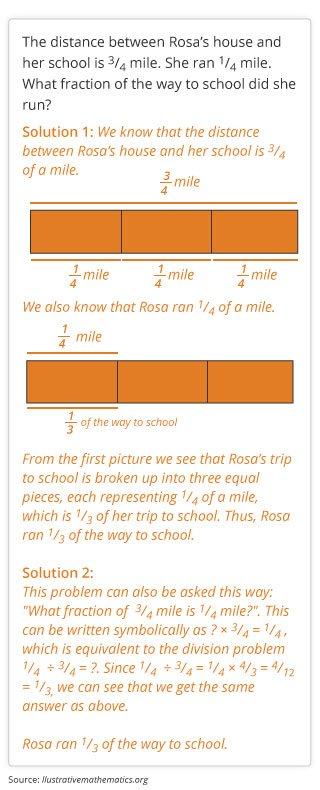
Sixth graders work on three main skills using ratios: 1) ratio and rate language; 2) recognizing, generating, and graphing pairs of equivalent ratios; and 3) comparing ratios. Ratios express the relative size of two (or more) quantities or numbers. Kids talk about ratios using words such as 3 to 2, or 3 for every 2, or 3 out of every 5, or 3 parts to 2 parts.
Watch how sixth graders calculate equivalent ratios.

Sample problem 2: Using ratios to solve problems
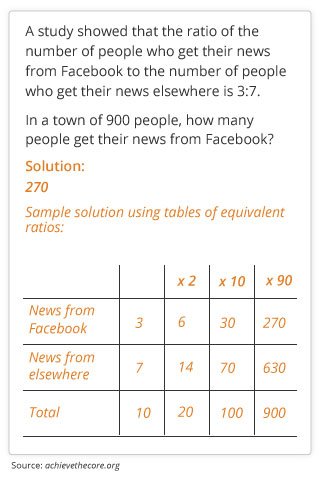
Ratios have associated rates. For example, the ratio 3 feet for every 2 seconds has the associated rate 3⁄2 feet for every 1 second. In sixth grade, students describe rates in terms like for each 1, for each, and per. This is called the unit rate.
Students can calculate the unit rate of a ratio to compare two quantities or find proportional rates (like speed). In the following problem, students must draw on their knowledge of rates to determine who walks faster per 1 second. Why? Because it’s difficult to compare walking rates when they’re in different amounts of time.
Sample problem 3: Calculating and comparing unit rates
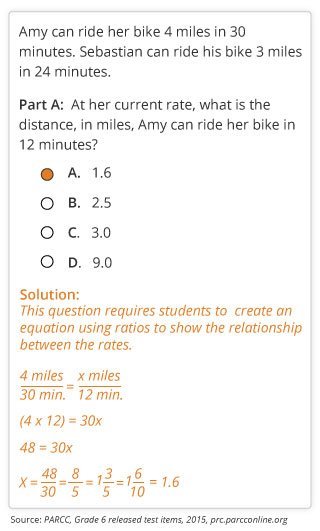
Students also learn about percents,which means per 100. As they become familiar with percents, students will be able to do mental math using common percentages known as benchmark percents, such as 10%, 25%, and 50%. Knowing how to do these calculations in your head comes in handy when you want to leave a 20% tip on a $36 restaurant bill, or when you want to know how much money you’ll save when a $35 pair of jeans is 15% off.
Sample problem 4: Percents
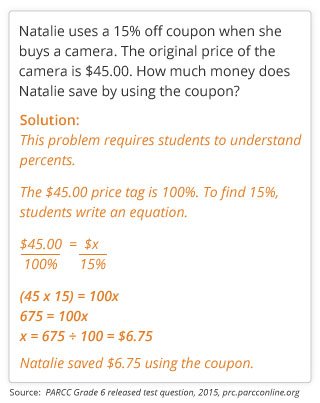
In sixth grade, kids step backwards, numerically speaking, to learn about negative numbers. On the surface, it may seem impossible for something to be less than zero, but negative numbers serve a purpose in daily life. If you accidentally take too much money out of the ATM machine, your bank balance could go below zero. If you live in a region prone to droughts or floods, the water level may be described as below or above sea level, with 0 representing sea level. Not enough water, or below sea level, is a negative number. By the end of sixth grade, your child should understand situations that involve negative numbers (like the ones just mentioned). Sixth graders should also be able to place negative numbers on a number line to show the relationship between numbers. (For example, –12 is less than –5 because it is farther away from 0 — and –12 degrees is colder than –5 degrees.)
Sample problem 5: Negative numbers
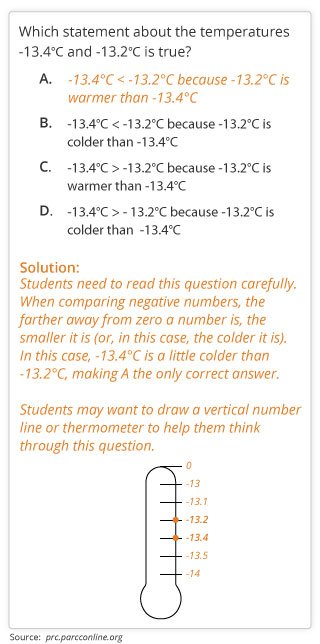
Since kindergarten, students have been writing numerical expressions, starting with basic addition, such as (2 + 3), and moving into more complex problems, such as (8 x 5) + (2 x 6). In sixth grade, students need to write algebraic expressions using variables, or letters, to represent unknown numbers. For example, subtracting y from 5 would be written as 5 – y.
Sixth graders use variables to solve word problems a lot. A test question might pose this situation: Daniel spent $10 on 5 candy bars. Write an equation to determine how much each candy bar cost. The answer is 5x = 10 or 10 ÷ 5 = x, where x is the cost of one candy bar. Students should be able to write the equation and explain what the variable stands for in the problem. Here’s another one.
Sample problem 6: Writing and solving equations with variables

Sixth graders also use variables with ratios and rates. For example, let’s say you’re driving at a speed of 60 miles an hour. Students may be asked to create an equation showing the distance traveled after 3 hours. It would look like this: 3 x 60 = x.
In the following word problem, students must first identify the patterns for x and y before calculating the relationship between x and y.
Sample problem 7: Working with variables in ratios and rates

Sixth graders also work with inequalities, which are expressions that show two things that are not equal. Inequalities use the signs > (greater than), < (less than), or ≠ (not equal). Students should be able to interpret inequalities and represent them on a number line.
For example, the inequality x > –2 shows that the variable, x, is greater than –2. Since x is a variable, it includes all numbers greater than –2, such as –1, 0, 1, 2, 3, 4, etc. The inequality x > –2 is shown on the number line below. The arrow means that it goes on forever in that direction, meaning that x can equal any number greater than –2.

Sample problem 8: Inequalities
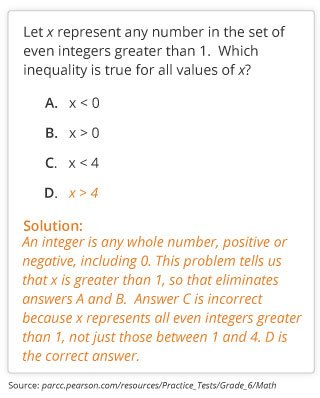
The most important thing you can do to help your child with math is to have a positive attitude toward math, and find ways to demonstrate that to your child. Why? Because research shows that a parent’s attitude toward math is contagious; so just by having a good attitude you are helping your child with math. So yes, you are a math whiz — and your child will be one, too.
There’s a lot going on in sixth grade math. You’ll want the teacher’s help identifying your child’s trouble spots so you can help work on those at home. Is your child having difficulty doing the problems — or is it the math reasoning? (For example, does he struggle with dividing fractions, writing equations, or illustrating proportional relationships with ratios — or is it more that he doesn’t get why dividing a fraction by a fraction requires multiplication?) Ask the teacher to help identify the specifics.

If this were the Academy Awards, this category would be best supporting actor and actress. They’re not the stars, but the movie wouldn’t exist without them. This content is given less weight on the PARCC exam, but it supports the major work of the sixth grade and sets your child up for success in future grades.
For example, solving two-step, multi-digit problems improves understanding of algebraic expressions, which is a major area this year — and will be a major skill in future grades, too.
Also, students are expected to know how to collect and represent data as part of learning about statistics and probability, which is an additional skill that builds on the major skills like analyzing relationships between quantities using ratios and understanding negative numbers.
Like Brussels sprouts, math has a bad rap. Both are good for you, and both can be enjoyable if properly prepared. So spice up the way you talk to your child about math — and maybe let her use the Brussels sprouts to juggle.
Is your child on track to succeed in sixth grade math? Ask the teacher! If not, what are his strengths and weaknesses? Find out how you can help your child work on weak areas at home.

How did I do this? How do I know I got the right answer? Can I explain my work to the class? Sixth graders will be asking themselves these questions all year. Throughout the year, they need to use their new knowledge of ratios, the number system, and expressions and equations to explain how they arrived at an answer. They need to prove why their answer to a problem is correct. Also, they’re asked to (nicely) evaluate their classmates’ work to identify solid math thinking and to make suggestions that will make it even better. Sixth graders need to be able to use their knowledge of mathematical rules to defend their work. For example, they need to be able to explain why –3 x –2 = 6 or why –3 x 2 = –6.
Students should be able to analyze how a problem has been solved and, if it’s not right, point out where things went wrong. Kids also need to be able to explain what the correct solution would be and how — and why — it works. Sixth graders need to be able to use mathematical language and definitions in their explanations.
Sample problem 1: Evaluating other kids’ answers using reasoning
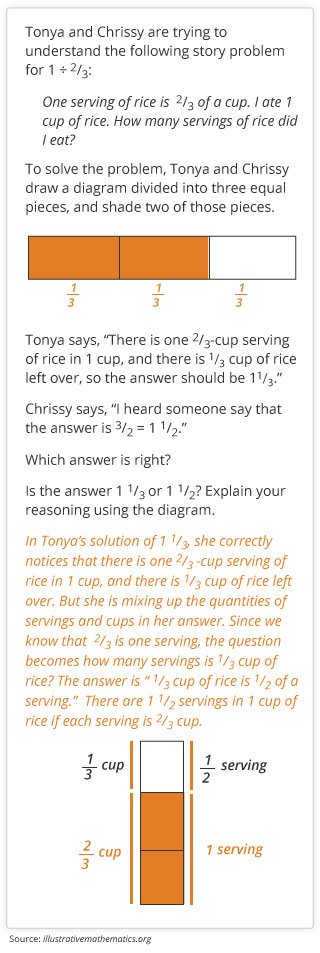
Students need to be able to use the skills they know to answer questions and figure out how to go about solving multi-part problems. They also have to understand the math well enough to explain their work and use their knowledge of concepts and procedures to support their reasoning. The following problem requires all of that.
Sample problem 2: Supporting reasoning

Here’s a riddle based on rational numbers (Hint: including negative numbers). See if your child gets it. Use jokes and riddles to get into the right mindset: math is fun and entertaining!
A physicist, a biologist, and a mathematician are sitting on a bench across from a house. They watch as two people go into the house, and then a little later, three people walk out.
The physicist says, “The initial measurement was incorrect.”
The biologist says, “They must have reproduced.”
And the mathematician says, “If exactly one person enters that house, it will be empty.”
You don’t have to wait for the parent-teacher conference to talk to your child’s teacher. Arrange a meeting and talk sooner rather than later. Ask the teacher what the class is working on, and ask specifically what your child is doing well and where he is struggling. If you can, look at examples of your child’s work while you talk — it makes it easier to understand how you can help. Ask for tips on how you can help your child improve, as well as suggestions for other resources outside of school, such as websites or workbooks.

Modeling and application means taking a problem from everyday life and using math to solve it. This may mean creating a graph, picture, number line, table, equation, or other model to analyze and represent the relationships between different quantities. The purpose is to help kids learn different ways to visualize, understand, and solve real-world problems.
Modeling is at the heart of mathematics; it’s the link between what students learn in class and the process they use to make sense of (and solve) real-world challenges.
Sixth graders are expected to be able to solve problems even when the path to solving the problem isn’t clear. Students should be comfortable asking and answering questions such as: What is this problem asking me to do? How do I know this is correct? Does this make sense? How else can I solve this?
See how a sixth grader solves a word problem involving ratios.

Sixth graders are expected to figure out how to solve problems that don’t tell them which procedures or techniques to use. Students need to identify the important information in problems, figure out which steps to take, and choose the best tools to use (for example, pictures, graph paper, or a ruler) to find the answer. Many problems can be solved using a variety of techniques. Your child should be able to find the technique that works for him, while also understanding how and why other approaches work.
Sample problem 1: Analyzing a problem and using models to solve it

Students learn to show and make sense of how quantities change in relationship to one another using graphs and tables. For example, in the sample problem below, students are asked to use a model to determine the feasibility of completing a project in a specific amount of time.
Sample problem 2: Creating a model to understand and solve a problem

Sample problem 3: Evaluating a model to see if an answer makes sense

The math gene is a myth! There’s a common misconception that some people are born with a math brain and some aren’t. Not true. With support, practice, and encouragement, kids can — and will — learn math.
Teachers want to work with you to help your child. Ask for specific information about your child’s strengths and weaknesses. What math exercises can the teacher suggest for you to try at home? Maybe there’s a game that’s excellent modeling practice — or a card game that boosts reasoning skills. The teacher will know: all you have to do is ask!

GreatKids created this guide to help you understand your child's state test scores and to support your child's learning all year long. We worked with PARCC and leading teachers in every grade to break down what your child needs to know and exactly how you can help